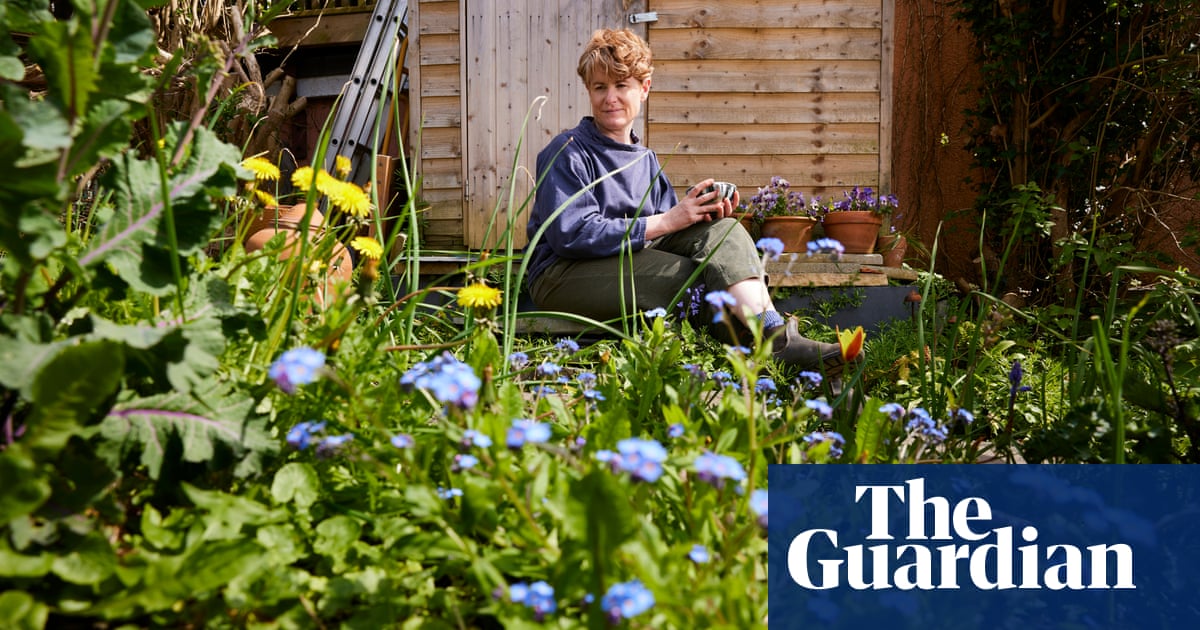
After almost 30 years of gardening, several of those at fine institutions such as the Royal Horticultural Society and Kew Gardens, I’ve realised that much of what I was taught is, if not wrong, not exactly on the mark either. All that laboured effort – the weeding, the fertilising, the digging, the tending and pruning, the selecting and conforming – it’s not working. Not for the plants, the soil or the community around them, which includes you and me. Indigenous cultures everywhere have based their practices on observing and honouring the ecology, while we in the “developed world” wrote down our rules. Our attempt to control nature has perpetuated poor relations with all the beings in the garden, turning everything into some sort of battle, or endless regimes whether that’s mowing, hoeing, watering or attacking some critter. It is a lot of work and these days way more than I am prepared to put in. Now spring is finally unfurling, this growing season, perhaps rather than going to work in our gardens, we could all relax a little, spend more time looking and listening, waiting rather than reacting, being in the garden as much as actively gardening. Here is how it’s done.
Throw out your spade
If you are even faintly interested in gardening you will have heard of “no dig”, in which you eschew your spade and take up a hoe instead. Rather than turning the soil, a structure that has been hundreds of millions of years in the making and thus has thought long and hard about which way up it should be, you lightly hoe or “tickle” the soil to remove any unwanted weeds and leave its multitudes of microbes, fungi and insects intact, exactly where they want to be. Happy microbes make for happy plant roots, better able to take up nutrients, fight off pests and diseases and withstand drought. As you keep doing it, there will be fewer weeds to remove.
Every soil has its weed seed bank: the adage goes one year’s seed is seven years of weed, but actually it’s more like decades for several of them. They are there not to annoy you, but to act as a lifejacket to the soil. Exposed, weed-free soil is very easily damaged or eroded by the weather: the sun bakes it, the wind harries, the rain pelts it, either compacting it or if a deluge comes, causing run-off. Again, those several million years of evolution weren’t a system sitting still, but advancing to a point of self-resilience. The vast majority of weed seeds need light to germinate. The more you disturb the soil, forking it over, digging things up, the more light you let in and the more the soil has to rush to protect itself. It flushes its weed-seed bank as a protective coat to hold the system together.
Ease off weeding
Talking of weeds, it’s time we ditched the word altogether. Even the Chelsea flower show is rebranding weeds as “hero plants”. Perhaps we can talk of them as common folk or elders (they’ve been around a lot longer than us), because every weed in your garden is trying to tell you something very important.
The more one type dominates, the louder the sermon is. Dandelions are saying your soil is a little compact, low on surface nutrients, particularly calcium and potassium; nettles tell you there is too much surface nitrogen (not as good as it sounds). A flurry of annual weeds – bittercress, chickweed and mouse weeds – say your soil is dominated by bacteria, while thistles, docks, green alkanets and comfrey are another sign that the surface is a little low on nutrients and only those with long tap roots to mine the sub-soil layer can thrive. Brambles tend to proliferate where there is excessive nitrogen, but the land has been left alone so they can take better hold. There is some evidence, though, that they have a potential role in the natural regeneration of tree seedlings: deer won’t browse in the middle of a bramble thicket and in a woodland this means the tree seedlings won’t get nibbled, while the mycorrhizal fungi will tap into the woodland network to boost the seedlings with enough growth to make it up and out of the thicket.
Once you start looking into the ecology of anything that we flippantly call a weed, you will discover that it is key in recycling nutrients, providing food in the form of nectar and pollen for all manner of insects, in all manner of weather. And not just for pollinators, but also for things such as leaf miners that turn into micro-moths, and flies that turn into food for hungry mouths reaching out of the nest, which turn into food for raptors flying high above. “I know,” I hear you cry. Of course you do, but I bet you still go out weeding when you don’t have to.
Many of these common folk arrive to help the soil out. If you ease back on the weeding (you will still have to intervene sometimes), and instead pay attention to the soil, many of the common folk will quite quickly become occasional folk instead. Annual ones are a sign that the soil has become bacterially dominated, having evolved from alluvial flood plains to meadows to fields, and thriving in the company of bacteria. They do not thrive in the fungally dominated soils of woodlands. Fungi thrive in soil rich in carbon because that is what they eat.
If you have too many annual weeds, add more carbon to your soil in the form of bulky homemade compost, cardboard (could be shredded, could be laid down as a sheet, could be added to your home composting), or brown leaves (you don’t even have to make leaf mould). You don’t have to dig it in – the worms will incorporate it all into the soil. That is, if you gave up your spade because one of the biggest threats to earthworms is our habit of ploughing and digging, partly because if you are chopped in half, you don’t regrow, and because worm tunnels have their own beautiful architecture that supports the soil, but not if they have collapsed.
Embrace rot and death
So, we have thrown away the spade, considerably loosened up on weeding; now it is time to relinquish tidying up. We all do it, remove a yellowing or nibbled leaf, sweep up the spent leaves and pick up sticks, prune out the dead and dying. In part because the idea was that all this material would harbour slugs, other pests and diseases. It might, but one soul’s pest is another’s supper. It is true slugs rather love a pile of damp, slightly rotting leaves, but so do the beetles that hunt them.
This story is played out over and over again: if one thing proliferates in a natural system something else, sometimes many things, will come to dine on this opportunity, to restore the balance. A garden allowed to find this balance doesn’t have pest or disease problems – it has beings, who are living and dying, sometimes thriving, but rarely at the cost of the whole system. This balancing act takes time, several years or more, but I promise you this: even the slugs settle down. Rotting, disease, pests are just the Earth’s recycling system. It is not a great leap of faith to trust time. Plants have been around far longer than we have been gardening, with plenty of time to work on the nuances of reciprocity.
Stop chasing fast growth
Ever since the second world war we have been falsely worshipping nitrogen and phosphorus as kings in the fertiliser game. Synthetic fertilisers, a very bad hangover from bomb manufacturing, led us to believe we could rig the system. Using them meant farmers could turn every bit of soil into a field, for a while at least, and it trickled down into how we gardened.
There is a much wider debate about excessive fertiliser use, in particular nitrogen, in farming, but that’s largely out of our hands. The garden isn’t.
There is no need for manufactured chemicals of any kind here. First, all soils differ but synthetic fertilisers, particularly the kind sold to gardeners, take a one-size-fits-all approach. Regardless of where you are, you apply the same amount of plant food. These synthetic fertilisers don’t stay in situ; they run off. And there is evidence that over time, they can deplete soils of stored carbon, reducing fertility, even if organic matter is still added. In short, if you buy fertilisers you are paying for short-term gains. Homemade compost is free and it will build your soil, helping store carbon and feeding your plants. Even if you make it really badly.
Compost in situ
If you want an even more carefree approach, you can do most of your composting without heaving stuff around. Don’t clear away your spent crops, leave the pumpkin stems and leaves, take down the old tomato and bean plants and let everything lie on the soil. You can cover it to speed things up – market gardeners tend to use black plastic for convenience, but cardboard is plentiful, free and easy enough for a small garden. Covered or not, this allows the crop residues to go straight back to where they came from. If you want to plant straight back into the space you just harvested or cleared, try mowing, strimming, shredding or chopping up by hand the spent crops and planting straight into that. It’s quicker, avoids hauling stuff to the compost heap and back and again and makes for wonderful, friable soil. That whole notion about hoeing and raking the soil to make a fine tilth to grow in? Turns out it’s better done by the soil system than your sweat.
I’m not suggesting we should give up compost. It is still the best way to deal with household organic matter, be that food waste, paper and cardboard, pet hair, etc. You just don’t need to bring in extra compost or manures especially for your soil, when in- and on-ground methods might get you to a richer soil with less effort and less cost. And if you do bring in compost, never, ever use peat. It is destroying precious peatland habitats that we need for carbon storage, clean water and flood management. Those that live on peat bogs don’t want to live anywhere else, so let us not destroy their home for the idiocies of gardening.
Encourage plant promiscuity
Finally, let us embrace the diverse, the slightly different, the variable in our flowers and foods. For millennia, we have been selecting and breeding plants so that they benefit us – this is our origin story. But for the longest time this was a laid-back process of letting the pollinators go to work, saving seed, growing on and noticing what worked best for the conditions where you were. It is known, technically, as creating a landrace, an ancient cultivar that is variable, often containing many alleles (forms of genes) that are not present in modern highly bred cultivars. Landrace gardening is the opposite: akin to a plant orgy, you let all your carrot varieties, or whatever it is you are growing, cross-pollinate with each other to create a diverse breeding population. It is a survival strategy that diversifies the gene pool, making it better future-proofed than something highly bred.
The result is a beetroot or a bean or flower that is not uniform; as the different alleles play out their expression, so a landrace varies in colour, size, texture and even flavour. Anyone can become a landrace gardener. It’s a fun, five-year-plus experiment that takes very little effort and will reward you with vegetables and flowers that work entirely for your system of growing and your soil. Don’t want to spend all summer watering excessively (can I remind you how hot last summer was)? Breed a leafy green that doesn’t need it. Got poor soil? Breed a potato that loves it. Want a tomato that tastes of something but doesn’t mind a late frost? It’s all possible.
Sow all the named varieties that have the characteristics you want, grow them and, with the help of bees promote promiscuity and let them cross-pollinate. Select and save seed from only the ones that do well in your soil. Start again next spring, sowing your saved seed. Up to half of it might not survive, but you’ll have oodles of seed, so it doesn’t matter. Let the pollinators at the new plants, select seeds from the ones that are working and keep going. In a couple of seasons, you can have garlic that is entirely adapted to your soil – it might take a few more years to find that perfect pumpkin or tomato.
We don’t know where we are heading as far as our future on this planet is concerned, but we might as well go there prepared with a wide gene pool, in relation with our common folk plants and their communities, in awe of our insects, fascinated by our fungal friends, with our soils and our energy replenished. And like any friendship group, that is best done by hanging out, kicking back and enjoying each other’s company.
In all of this I am not advocating giving up on gardening, but shifting the perspective on what needs doing. If the dandelion, dock or bramble isn’t in the way, leave it. If the plant goes down in an orgy of aphids, leave it for some other garden being to clear up. Let plants die in place, learn to watch and observe before you make a move. You’ll see that nature is way more willing to help than cause trouble.












